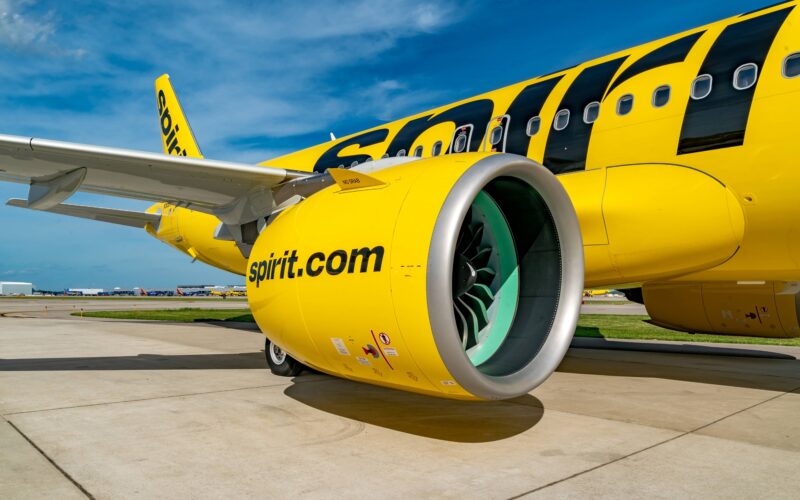Spirit’s Order Conversion Raises Questions About the Future of the A319neo Program

As part of its Q2 2023 financial results announcement, Spirit Airlines has revealed that it has converted its Airbus A319neo orders for larger A321neos, resulting in more than 30% of the A319neo’s backlog disappearing. Could this be the end of the program?
“In late July 2023, the Company signed an amendment to the A320NEO Family Purchase Agreement to stagger the delivery of ordered aircraft over the next six years more evenly,” read the airline’s Securities and Exchange Commission’s (SEC) filing. Spirit Airlines detailed that it pushed a number of aircraft deliveries into 2025 through 2029, as well as converting its 31 A319neo orders into orders for the largest member of the family, the A321neo.
As such, the backlog for the A319neo fell from 92 to 61 between June and July 2023, according to Airbus Orders & Deliveries filings for the respective months. The European plane maker also delivered a single A319neo to Tibet Airlines on July 20, 2023.
A familiar story
This story is not unfamiliar, considering that this is exactly what happened to the Airbus A318ceo, the smallest member of Airbus’ first single-aisle jet family.
Arriving later than its bigger brothers, the A318ceo never really gained traction sales-wise, with airlines only ordering 80 aircraft before Airbus eventually delivered the final aircraft, configured as an Airbus Corporate Jet (ACJ), to Hong Kong-based BAA Jet Management based in November 2018, according to ch-aviation.com data.
Out of the 80 that were delivered, 39 have now been scrapped and 17 retired, with 24 remaining active. Of the 24, only six are passenger variants, operated by Air France (four A318s) and Romania’s TAROM (two), with the remainder being configured as ACJ aircraft, as shown by ch-aviation.com data.
Meanwhile, Airbus has only delivered 14 A319neos so far, split between five ACJ319neos and nine A319neos. The latter can only be found in China and the autonomous region of Tibet, where China Southern Airlines operates four, while Tibet Airlines has taken delivery of five as of July 31, 2023.
Bigger aircraft is the trend
Comparing the backlogs of the A320ceo and A320neo aircraft families, one trend is clear: airlines want bigger aircraft.
In total, carriers ordered 80 A318ceos, 1,486 A319ceos, 4,763 A320ceos, and 1,791 A321ceos, while the A320neo aircraft family order split is 61 A319neos, 4,297 A320neos, and 5,259 A321neos. Overall, airlines have begun favoring bigger aircraft, especially as there is an increasing lack of slots and gates at airports, limiting growth opportunities with smaller aircraft.
Another nail in the A319neo’s coffin was the A220-300. While the ex-Bombardier product does not have the benefit of fleet commonality with the rest of the A320ceo/A320nceo family, both seat the same number of passengers in a single-class configuration at 160. Yet the A220-300 is much lighter, with its Maximum Zero Fuel Weight (MZFW) being 58,060 kilograms (128,000 pounds), whereas the maximum MZFW of the A319neo is 60,300 kg (132,939 lbs).
Still, the A319neo has a longer range compared to the A220-300, with Airbus claiming that the maximum range of the former is 6,850 kilometers (3,698.7 nautical miles), while the latter’s is 6,297 km (3,400.1 nm).
However, the A220-300 can boast about its arguably superior passenger experience. According to Airbus’ Airport Planning publications for both, the seat width of the A220-300 is 0.48 meters (19 inches), while the A319neo’s wider seat configuration has a seat that is 0.46 m (18 in) wide. The A319neo’s wider aisle configuration results in the seat being 0.43 m wide (17 in).
And the wider seat configuration of the A319neo takes up a significant amount of aisle space, as the aisle is as wide as 0.48 m (19 in), while on the A220-300, the 3-2 configuration aisle is 0.51 m (20 in) wide.
Another potential spanner in the works for the A319neo will be the stretched A220, unofficially known as the A220-500. While Airbus is yet to provide a firm timeline, the manufacturer has confirmed that it will be rolled out as soon as they can manage to ramp up the production rate of the A220-100 and A220-300. “The ramp-up on the A220 program is continuing towards a monthly production rate of 14 aircraft in the middle of the decade,” Airbus stated in its H1 2023 financial results announcement.
Stretching the A220-300 could result in Airbus maintaining the unparalleled passenger experience it can offer in the smaller narrow-body aircraft market, yet offering superior operational characteristics that neither the A319neo nor rivaling manufacturers’ products can offer.
At the same time, the ACJ319neo could rival the ACJ TwoTwenty, based on the A220-100, with more range and a much wider cabin, within the private jet market where convenience tops cost and revenue-related discussions.
At least for the A318ceo, the market for the ACJ318 gave a lifeline for the program for almost four years, as between December 2009 and November 2013, Airbus delivered nine private jets of the type, without a single passenger version being delivered within the timeframe, according to ch-aviation.com data.
The last passenger variant of the A318ceo, delivered to British Airways in September 2009, was scrapped in October 2021, ch-aviation.com records show.
“The A319neo makes perfect sense for airlines who are already operating an Airbus fleet, especially an Airbus Single Aisle fleet such as the A320s and the A321s,” an Airbus spokesperson said in an email to AeroTime. They pointed out that the fleet commonality provides flexibility with “cross crew qualification” and airlines operating their fleets optimally by interchanging between the smaller and larger variants in response “to alterning demand”.
Furthermore, the company’s representative pointed out that the Airbus A319neo performs exceptionally well at airports with difficult conditions, such as hot and/or high environments or where runways are shorter, requiring a more steeper approach/take-off performance.
“We are committed to delivering the aircraft our customers require,” they concluded.
